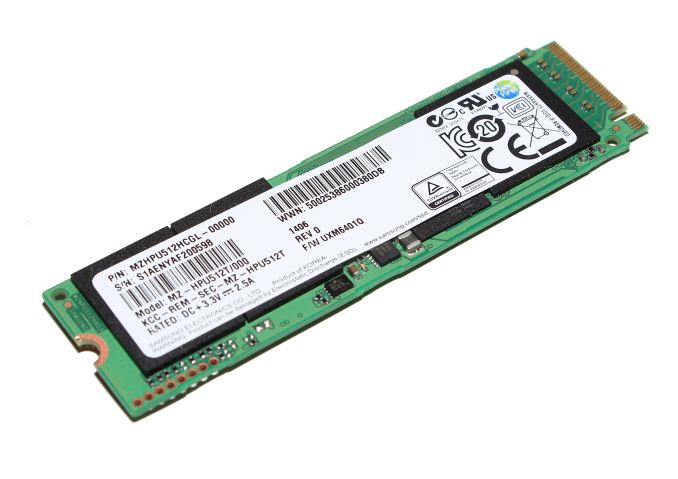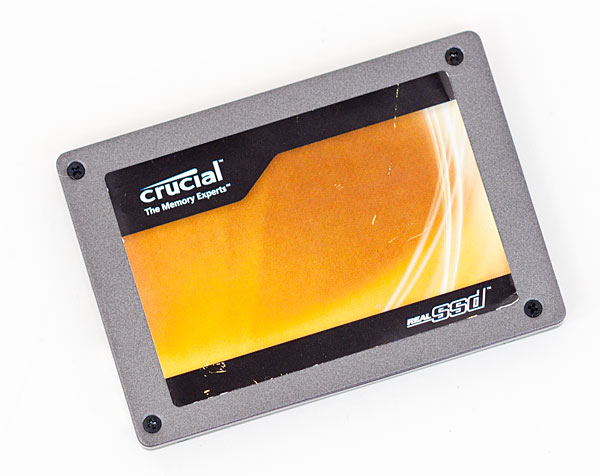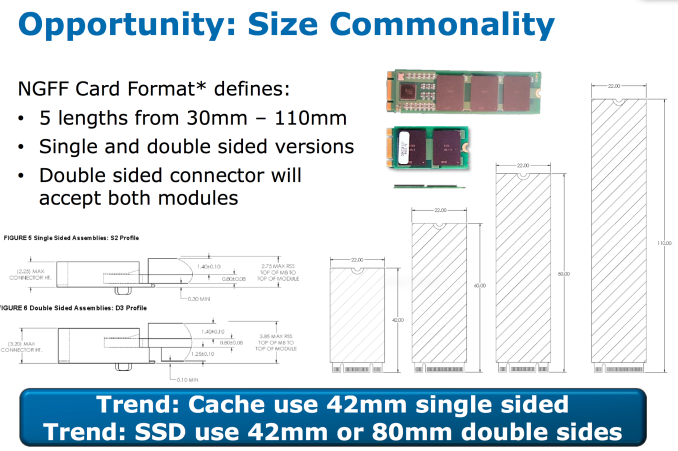Samsung SSD XP941 Review: The PCIe Era Is Here
by Kristian Vättö on May 15, 2014 12:00 PM EST
When SATA was introduced a bit over a decade ago, it provided major advantages over the old PATA interface. Not only was it faster and more power efficient thanks to the better signaling protocol, but the cabling was no longer big and clumsy with very limited length. It was no wonder that the industry quickly adopted SATA as the new interface for client storage and it has held its position throughout the years.
Since hard drives were the dominant storage media, SATA provided everything that the industry needed. The first generation SATA 1.5Gbps was already fast enough for the vast majority of use cases but about two years after the initial release of SATA, the second generation SATA was ready for prime time, doubling the throughput to 3Gbps. Even today's fastest hard drives can't fully saturate SATA 3Gbps, so there was obviously no rush to improve the interface as it already met the industry's needs. But that changed quickly around 2008.
The reason wasn't a sudden improvement in hard drive technology, but an emerging new technology that was based on non-volatile memory. We're talking about SSDs of course. The non-volatile memory part wasn't actually anything new as NAND has been around since the late 80s, but it was the first time NAND was being used in a PC form factor. Previously NAND had mainly been the choice for ultra mobile devices like MP3 players and phones but it was realized that the technology had the potential to be used in all computer-like devices, including PCs and servers. Since NAND was a solid-state semiconductor and it didn't have to rely on mechanical rotation, it allowed for much, much greater speeds. It's simply much faster to move electrons around a silicon chip than it is to rotate a heavy metal disk.
Obviously the first generation SSDs weren't all that fast and in many cases a traditional hard drive would still provide better sequential performance (although SSDs would destroy hard drives in a random IO workload). However, as the SSD companies learned to manage NAND and its characteristics better, the performance went up significantly. In 2009 we were already at a point where SATA 3Gbps was bottlenecking drives and a faster interface was needed to unleash the performance of NAND. Fortunately the Serial ATA International Organization (SATA-IO) had already released the standard for third generation SATA, which would again double the bandwidth to 6Gbps.
Crucial's C300
In 2010 we saw the first SATA 6Gbps SSD, Crucial's C300, make its appearance. Back then SATA 6Gbps wasn't integrated into chipsets yet and users had to buy a SATA 6Gbps PCIe card (or a motherboard with a third party SATA 6Gbps controller) to utilize the drive's full performance, but as soon as Intel was ready with their 6-series chipsets with native SATA 6Gbps support, every man and his dog came out with a SATA 6Gbps SSD.
But there was a problem. SATA 6Gbps still wasn't fast enough to meet the needs of SSD manufacturers as they were already able to saturate it. SATA-IO was given a difficult task: they would have to come up with a new standard with drastically better performance only a few years after the previous strandard had been announced. Not only would it have to be faster, but it also needed to be cost and power efficient. Instead of developing the SATA protocol further, which would have been expensive and time consuming, SATA-IO decided to utilize an existing interface found in every mainstream computer: PCI Express.
To allow backwards compatibility with the SATA interface, SATA-IO came up with two standards: SATA Express and M.2 (formerly NGFF). The idea behind SATA Express is that it routes PCIe and SATA 6Gbps signals to a single connector, which can then be used to connect either PCIe or SATA devices depending on the drive. It's mainly aimed at the desktop crowd and we did an extensive review of it just a while ago. M.2 on the other hand is the successor of mSATA and is electrically very similar to SATA Express. It also supports both PCIe and SATA 6Gbps signals, although ultimately it's up to the PC OEM to choose whether it will route both to the slot (i.e. you can have an M.2 slot with just PCIe or just SATA functionality).












110 Comments
View All Comments
RamCity - Monday, May 19, 2014 - link
The Lycom M.2 to PCie adapter does a reasonable job with small form factor computers. It has a low-height bracket in addition to the standard height one. Note though, you can't boot the XP941 in any windows PC with one of these adapters as far as we know - it wont show up in the bios as a bootable device. Only in a 2006-2012 Mac Pro under OSX will it be bootable.Rod
Oscarcharliezulu - Monday, May 19, 2014 - link
Nice job anandtech... You detected what country i was reading this from and inserted appropriate text/prices? Great job. Appreciated.kizh - Tuesday, May 20, 2014 - link
still running my sandy 2500k that did 4.8 reliably until I updated bios. I bought a z67 board that had a pcie 3.0 x 16 lane as an early adopter. The only thing worth upgrading on it was the graphics so bought a 780 (on accident thought it was a 780 ti) I spent about 24 hours of my time researching making it work on a early version of uefi and trying multiple set ups. Gonna send it back, its not worth upgrading my whole system for this.Never buying another feature that isn't being used yet, by the time its truly a standard your warranty is over and FU if it got tweaked a little.
Got 2 M2 in raid, no trim ever bothered me. Its fast enough, don't need this. Maybe if a whole system upgrade was as fun as it used to be,
Right now all I see waiting for is a 4k display port standard and some nicer models coming out. I want to throw money at these guys but not for next to nothing,
I'm not rich by any measure but dumped money on tech as a hobbyist.
kizh - Tuesday, May 20, 2014 - link
oh just to clarify I know it would only be pcie 3.0 with ivy, I didn't expect that chip to be such a let down. Still this should have worked at pcie 2.0. Also when I say m2 I'm talking about the model name of my ssd's. not m.2just some clarifications
sfgebrqy - Wednesday, May 21, 2014 - link
I would have bought this in a heart-beat if it weren't for two things:1) Average/bad 4k random read/write
2) Abysmal 4k scaling with QD
The killer feature for this SSD is without a doubt its sequential performance. Compared to any single SSD alone, it blows it out of the water on the benches, whether
practical or synthetic.
The caveat is "single SSD". RAID 0 can always be used to boost sequentials. Maybe not exactly linearly, but close to linearly. Take a look at the review for 2 Samsung 840
Pros in RAID 0 (page 3). I can't link (or even mention the website) it because the comment filter says its spam, so take a guess and use Google. Sequentials are nearly
doubled for both read and write.
The kicker is that this CANNOT be done for random I/O at low QD. Which is to say, if we wanted better random I/O from XP941s, we couldn't RAID them together to do it. In
fact, RAID typically makes random I/O marginally worse at low QD due to overhead. See the aforementioned review (page 4).
RAID does multiply random I/O at high QD, but with XP941 4k QD scaling non-existent to begin with, it's a lost cause.
Even if we did want to RAID XP941s together, I can't seem to find any tests/reviews of more than two at once, let alone a RAID controller capable of putting more than two
M.2 devices in RAID 0. Meanwhile, there are plenty of RAID controllers capable of pushing 16+ SATA3 devices (albeit bottlenecked at x8 PCIe 3.0).
The bottom line is that if I found out that my current SATA3 SSD RAID 0 array wasn't putting out enough sequential, I could just add a few more SSDs to solve the issue. If I
found out that my XP941 array wasn't putting out enough random I/O, there's nothing I could do to fix it.
If you're in the market for single SSDs and your system can handle M.2, then this is the cream of the crop. If you have RAID arrays though, wait until M.2 becomes more
popular and Samsung pushes a new M.2 SSD with better random I/O performance.
skrewler2 - Sunday, May 25, 2014 - link
Sorry late to the party but this part of the article is just ignorant:"Using an SSD as a secondary drive can make sense for e.g. a video professional where the performance can be utilized as a scratch disk, but otherwise the only real use case for an SSD is as a boot drive"
What the hell?
aviv - Wednesday, June 4, 2014 - link
Hey gr8 reviewI got question about the graphs
Its log systemic
Does it means when its lower by 1/10 its just half of the value or
In between its linar
brentpresley - Thursday, July 3, 2014 - link
ASUS just released a new BIOS today (7/3/2014) that allows for M.2 boot support of the XP941.I just installed it and the BIOS can see the XP941 in AHCI mode now.
iBurley - Wednesday, December 3, 2014 - link
If put into the M.2 slot of one of the ASRock Z97 boards mentioned in the review, will this be running at full speed, or would I need an adapter like you tested with to use the full potential of the drive?On ASRock's website, under the port listing for the board, it states "1 M.2 (PCIe Gen2 x2 & SATA, Supports 30mm, 42mm, 60mm, 80mm, 110mm M.2 devices)" but I don't know if that just means the interface or if it would actually go over the PCIe bus instead of SATA.
SERGE 2015 - Tuesday, July 14, 2015 - link
I have AsRock's Z97 Extreme6 and XP941 and it is unfortunately NOT bootable out of the box. As it's been mentioned - once the system boots up using another EFI source, the XP941 becomes visible and can then load whatever been installed on it. This is due to lack of OpROM on XP941. The new Samsung SM951 been declared as "Supports Standard AHCI driver" though.